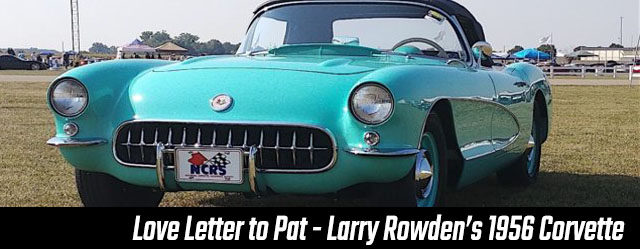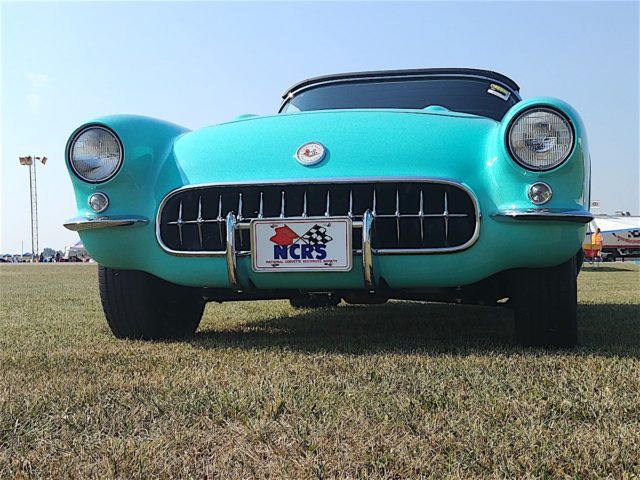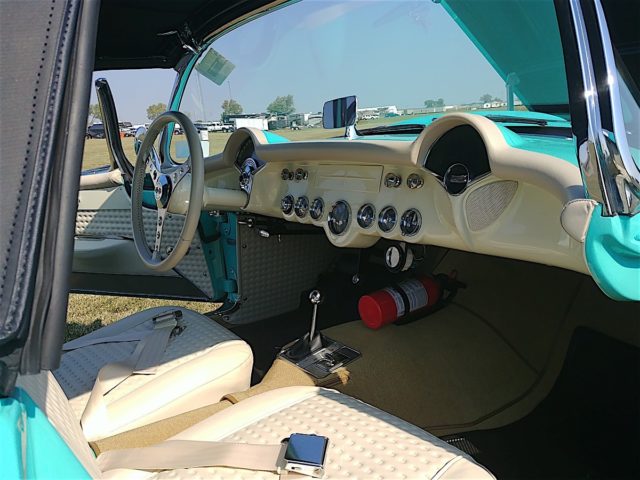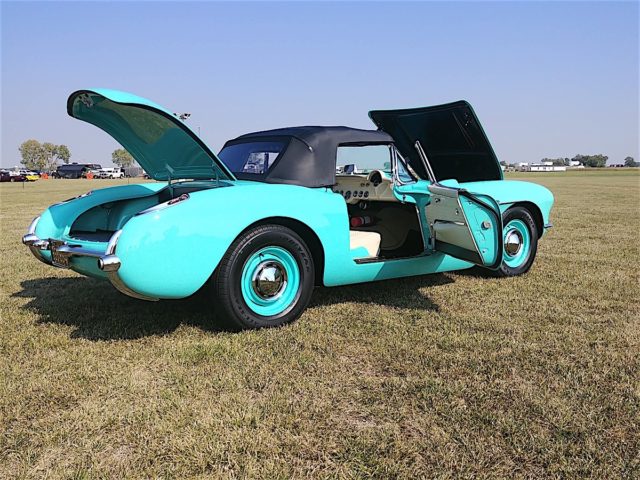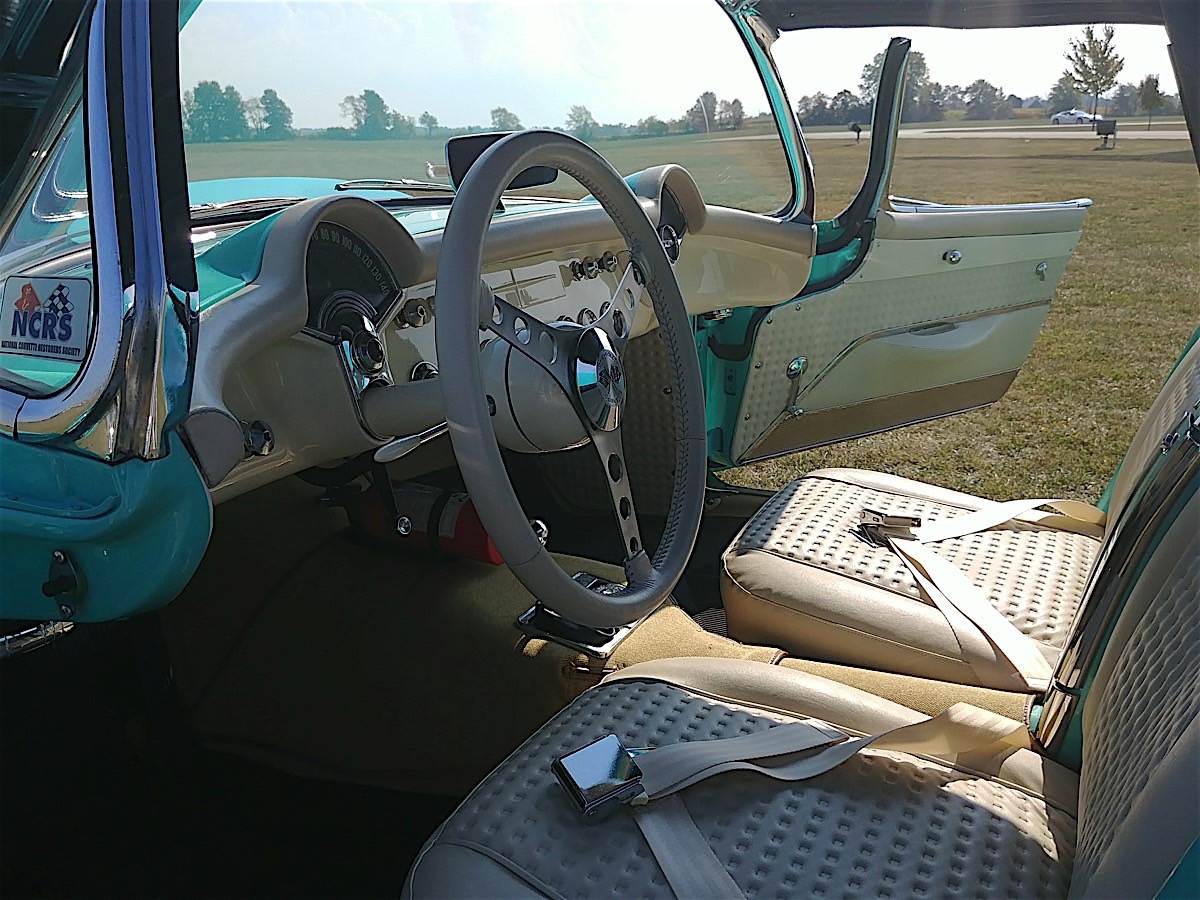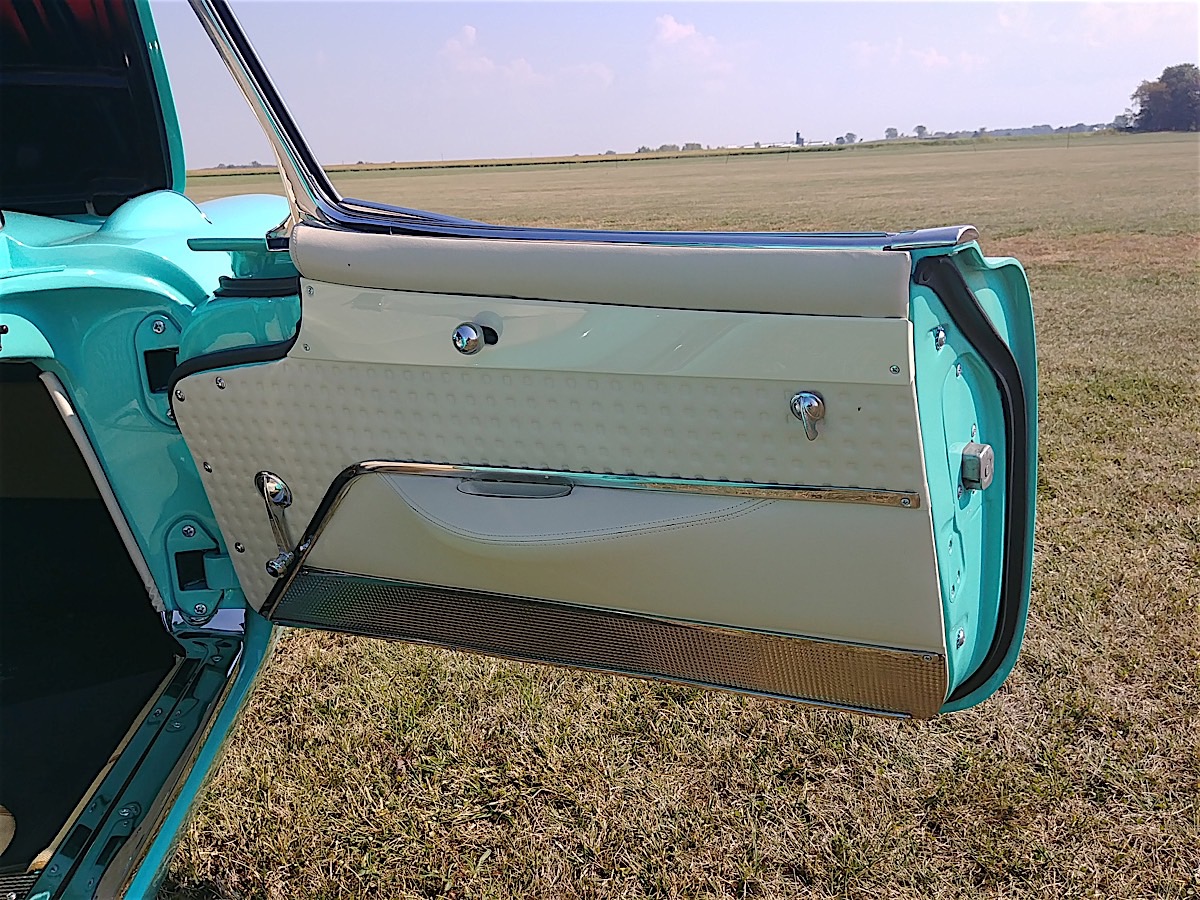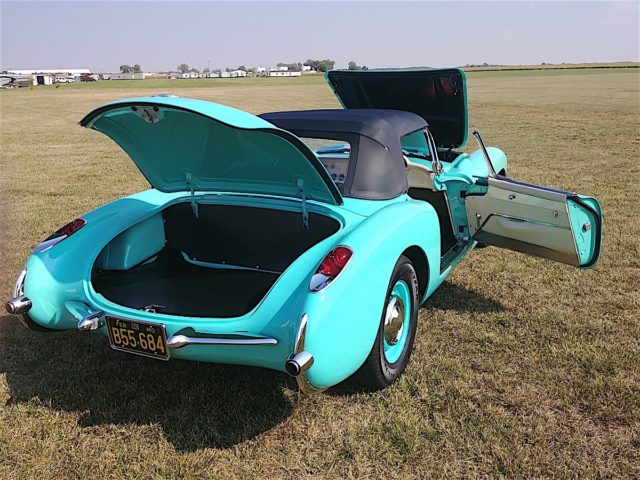Photography by Dave Cruikshank
“I’ve owned more Corvettes than most dealers have at one point or another,” joked Larry Rowden of Pacific, Missouri. While dozens of different iterations of Chevrolet’s sports car have been part of Rowden’s stable at one point or another, this Cascade Green example from 1956 holds a unique importance to him.
“My wife Pat once said to me that the only car she’d ever seen that she really wanted us to build or buy if we had the chance was a ’56 or ’57 Cascade Green Corvette – that’s her all-time favorite color,” he explained.
“When she was diagnosed with cancer I knew I needed to make good on that.” Not long after, Rowden got word through the grapevine that a dealer in Ohio had just taken delivery of a worn, but complete, ‘56 Corvette. But when the images of the car arrived in Rowden’s inbox, there was a bit of a surprise.

Rowden said that while he’s restored scores of Corvettes in the past, the Cascade Green ’56 and ’57 models were always particularly special to his wife. When she became ill a few years, Larry started the hunt for an original car in that color.
“I guess one of the previous owners had gotten caught in a sandstorm in Arizona and decided to repaint it another color. When the dealer sent me the pictures I said, “Son, this is burgundy.” But he assured me the car was originally Cascade Green, and when he cleaned up one of the door jambs and you could see that was the case.”
After three months of negotiations Rowden was able to lock down agreeable terms to purchase the car. He planned on bringing it home, cleaning it up a bit, and the couple expected to drive the ’56 more or less as it was. That plan didn’t last long, though. “I was just going to do a few minor things to it, but one thing led to another, and all of a sudden I’m doing a body-off restoration.”
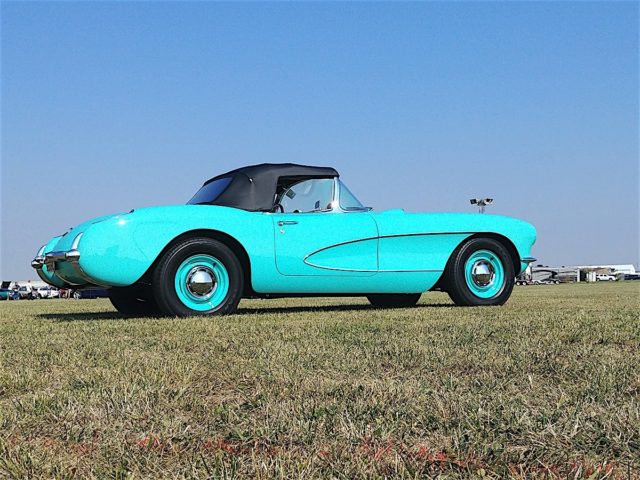
What was expected to be a quick freshening up to get the car road worthy and in the correct paint hue turned into much more when Rowden got a look at the car’s frame, which he said was in the best condition he’d seen on a C1. Though the car was from West Virginia, the second owner had spent a lot of time traveling between there and Arizona with it. The car had also stayed in his possession for more than half a century, helping to keep it free of the rust issues that so often befall these cars.
Two years later the results speak for themselves. The car has won more than half a dozen awards since the restoration was completed in March of this year, including two Best of Show awards, and Corvette aficionado David Burroughs beat out Corvette Online Editor Dave Cruikshank and anointed Rowden’s ’56 his Celebrity Judge choice at the 2017 Mid America Motorworks Funfest show in Effingham, Illinois. But as lovely as the car is as it stands now, the backstory of the build and the car’s history make this 327-powered C1 just that much cooler.
Built To Perform
When the Corvette was introduced to the world in 1953 the general public loved the styling, but enthusiasts were left longing for a bit more capability from the roadster. After a turbulent first few years on the market, Chevrolet was ready to deliver the goods, as evidenced by this particular ’56 model, which, according to the dealer, had been ordered with the express purpose of shutting down smack talkers at the track. “A lady ordered the car in ’56 to race it,” Rowden explained.
“Those things ran pretty good for what they were, even with the automatic in ‘em. It was a bare bones car – no heater, no radio, no power steering. It did have a power top, and she took that out and threw it away. She drove it for a year and raced it throughout that time before selling it off to a gentlemen in West Virginia.”
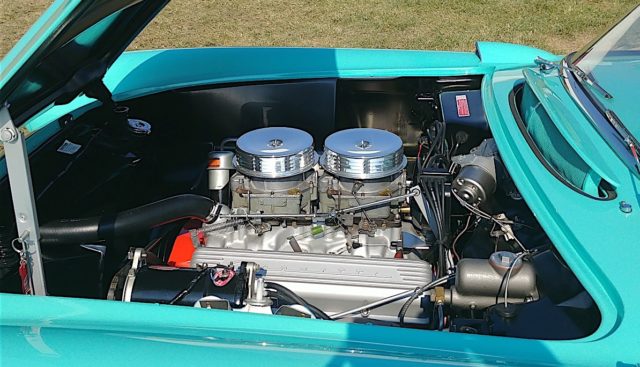
With the help of some industry pals for assistance on the body restoration and mechanical rebuild, Rowden set to work bringing this car back to its former glory. He says that, rather than trying to restore it to showroom stock, he tried to emulate how the original owner would have had the car set up for racing, so the 327 that the car had received after the second owner toasted the original was warmed over with L79-spec hardware.
That early exchange of ownership proved to be a blessing for this C1, as the next ownership stint would last significantly longer. “He kept the car for fifty years,” Rowden recalled, “Although he was in West Virginia, he did a lot of work in Phoenix, so the car spent a significant amount of time in Arizona as well.”
While that dry heat in the Southwest helped keep the car free from rust, it took its toll in other ways. “Along with the respray after that sandstorm he got caught in, in 1968 while driving back to West Virginia from Phoenix, the original motor blew out,” Rowden said. “He took it to a Chevrolet garage and they just swapped out that engine for a brand new 327. Back then nobody cared whether or not it was matching numbers, of course.”
So when Rowden took delivery of the ’56, what he had was essentially a relatively unmolested – but also non-numbers matching – example that would serve as a great candidate for a restoration in which Rowden could take a few liberties in the overall concept without feeling any sort of penalty for straying from the car’s originality.
The Road (Back) To Glory
Rowden’s original plan to simply bring the car back to its original color and make it road worthy went out the door shortly after delivery. “When we started on it, were we thinking of just doing a basic cleanup and maybe just spray it,” Rowden recalled.
“But I started working on the frame one day, and it was so perfect that I told my wife, “We gotta do this car – it’s just too perfect. And had one of my buddies come out and look at it too. He’s retired now but he was one of the best glass guys in the country. He looks at it and says, “Geez Larry, this is a killer car, I mean killer car. So he and I basically took the car apart in my garage.
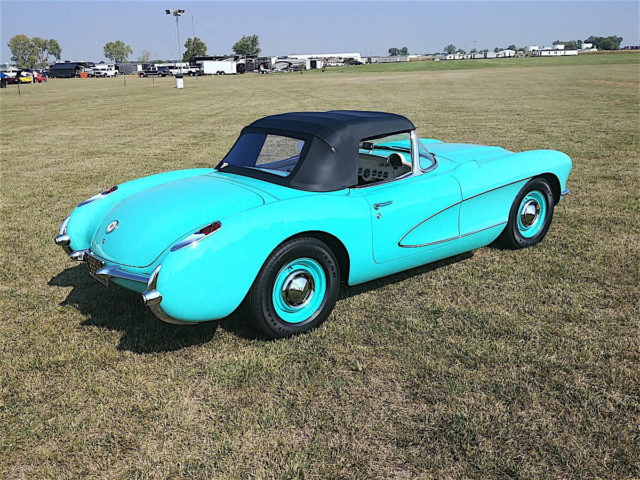
Simplicity and beauty of 1956 .Vette is amplified with dog dish caps and Cascade Green paint with matching coves.
He did most of the bodywork on it, fixing hairline cracks, etc. But he didn’t have a place to finish it, so once we got done, I took it down to Dave Clapper at Show Me Auto Body, here in Pacific, Missouri, who does all my painting. That’s where we lifted the body off the frame, took the rear end and suspension out, and so on. They did the paintwork and then reassembled that portion of it.”
At that same time the motor and gearbox were sent off to another friend with a machine shop. “The motor had never been touched – it was still standard bore – so we decided to build it to L79 specs.”
That included swapping over to the unique high-performance hydraulic camshaft used on that uprated mill from the mid-1960s, along with the small-journal crankshaft, and the wide bore and short stroke configuration that had helped Chevrolet offer a 327 V8 configuration that made more than one horsepower per cubic inch.
Outfitted with 10:1 flat top pistons, ported and polished cylinder heads, and a dual-quad intake and carburetor setup, Rowden estimates the mill is currently making around 365 hp. “It runs and drives just like it looks,” he noted.
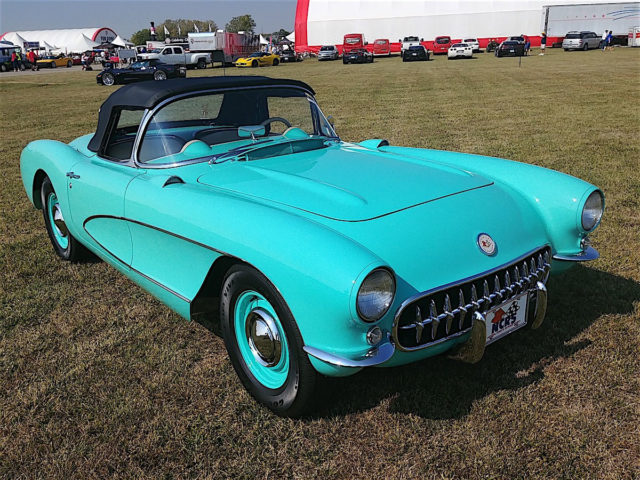
When he received the first set of pictures from the dealer who had the car, Rowden says he was surprised to discover that the car was burgundy rather than Cascade Green. But the dealer assured him that the original color was in fact what he was looking for, and a look at the door jamb seemed to confirm that. When they stripped down the car for the respray the dealer’s assertion proved true – it was Cascade Green underneath the top coat.
Of course doing a restoration this extensive on a car that’s over six decades old often requires some research along the way to make sure things come back together as they should. “My wife helped find a lot of the parts we needed to complete it, sourcing stuff through Corvette America, Corvette Central, and others. We tried to put everything back as “correct” as was possible, using the Corvette Black Book and online through Corvette Forums for reference.
The advantage I have it that I’ve probably done a hundred Corvette restorations over the past fifty years, so a lot of the stuff I already knew without having to consult somebody on it. Anything I wasn’t sure about, it was pretty easy to just hop on the Internet or go to the book for answers.”
Living The Good Life
Since the restoration the ’56 has seen its fair share of car shows, but it’s far from a trailer queen. “We drive it quite a bit – it’s already seen about 700 miles since we finished it,” Rowden explained. “With that L79 it’s a ton of fun to drive – you stomp on it at 70 mph and you’ve got gobs of power to pass or whatever you want to do. My only problem I have with it is the fact that if the top isn’t down, I don’t fit in it so well! I’m 6’1 and that car is made for guys a little shorter, so with the top up it’s a tight squeeze.”
Though the car has been entered in a number of car shows and, as result, secured a number of awards - including two Best of Shows and a pick from Corvette luminary David Burroughs at this Funfest show in Effingham, Illinois - Rowden says the car sees plenty of time on the road. "I don't build cars I can't drive," he told us, and the car has already clocked more than 700 miles since the restoration was completed.
Of course, no matter how meticulously restored a vintage car might be, there’s always something that needs doing. “There’s two little issues with it right now – for some reason when the gauges went back in, the fuel gauge and the temperature gauge stopped working correctly,” Rowden said. “Right now they’re going to stay in the car because we are still showing it at some of the larger local shows, but this winter the gauges are going to come out and they’ll be sent down to Corvette Clocks By Roger to have those redone.”
And, believe it or not, the paintwork isn’t finished yet. “The car has not had it’s final sand and buff so we’re going to that this winter as well,” he said. “By spring it’ll be dead nuts.”
We here at Corvette Online feel like this car is pretty stunning as it is right now, but if Larry says it can get even better we’re happy to take his word for it. We can’t wait to see how the car looks this time next year.



